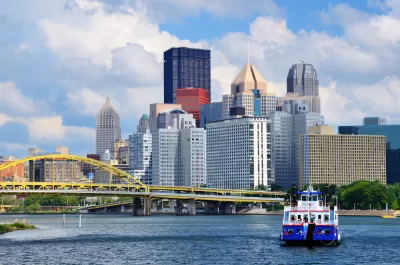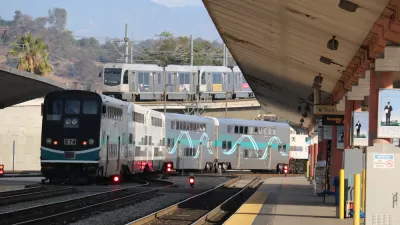The rules are changing, Tom Murphy says, and cities need to change, too.

At the Transit Oriented Los Angeles conference in October, local leaders shared valuable insights drawn from experiences throughout the Southern California region. Tom Murphy—senior fellow with the Urban Land Institute and former mayor of Pittsburgh—offered something different: an outside perspective that synthesized broad trends, observed from work in more than 100 cities.
Murphy urges cities to take advantage of what he calls our "Horatio Nelson Jackson moment," referring to the first person to drive across the United States in an automobile. Cities today stand on the brink of a new economy driven by technological innovation, population growth, and the effects of climate change, he says. To keep pace, they will have to create new tools and forge new ways of doing business.
"The federal government is sort of out to lunch," he says. "State government is largely in the black hole of American politics. That leaves local government to decide whether your community is going to succeed in a world where the fundamental rules are beginning to change."
Since the 1980s, he explains, local government in Pittsburgh has succeeded in transforming "one of the most environmentally degraded and one of the most economically depressed places in America" into one that has been called "the most livable city in America."
The takeaway for Los Angeles—where ballot-box planning has become increasingly common—is that local and regional governments must reinvest in city planning and develop clear, long-term visions for growth and livability.
"I didn’t hear this morning about strategy,” he noted. "What I did hear is that Los Angeles is doing a series of individual transactions without a broader strategy for the kind of community you want to have. This community needs a strategy—a vision. You need to know where you want to go."
FULL STORY: Former Pittsburgh Mayor Opines on LA City’s Lack of Leadership in Planning LA 3.0

Alabama: Trump Terminates Settlements for Black Communities Harmed By Raw Sewage
Trump deemed the landmark civil rights agreement “illegal DEI and environmental justice policy.”

Planetizen Federal Action Tracker
A weekly monitor of how Trump’s orders and actions are impacting planners and planning in America.

The 120 Year Old Tiny Home Villages That Sheltered San Francisco’s Earthquake Refugees
More than a century ago, San Francisco mobilized to house thousands of residents displaced by the 1906 earthquake. Could their strategy offer a model for the present?

In Both Crashes and Crime, Public Transportation is Far Safer than Driving
Contrary to popular assumptions, public transportation has far lower crash and crime rates than automobile travel. For safer communities, improve and encourage transit travel.

Report: Zoning Reforms Should Complement Nashville’s Ambitious Transit Plan
Without reform, restrictive zoning codes will limit the impact of the city’s planned transit expansion and could exclude some of the residents who depend on transit the most.

Judge Orders Release of Frozen IRA, IIJA Funding
The decision is a victory for environmental groups who charged that freezing funds for critical infrastructure and disaster response programs caused “real and irreparable harm” to communities.
Urban Design for Planners 1: Software Tools
This six-course series explores essential urban design concepts using open source software and equips planners with the tools they need to participate fully in the urban design process.
Planning for Universal Design
Learn the tools for implementing Universal Design in planning regulations.
Clanton & Associates, Inc.
Jessamine County Fiscal Court
Institute for Housing and Urban Development Studies (IHS)
City of Grandview
Harvard GSD Executive Education
Toledo-Lucas County Plan Commissions
Salt Lake City
NYU Wagner Graduate School of Public Service





























